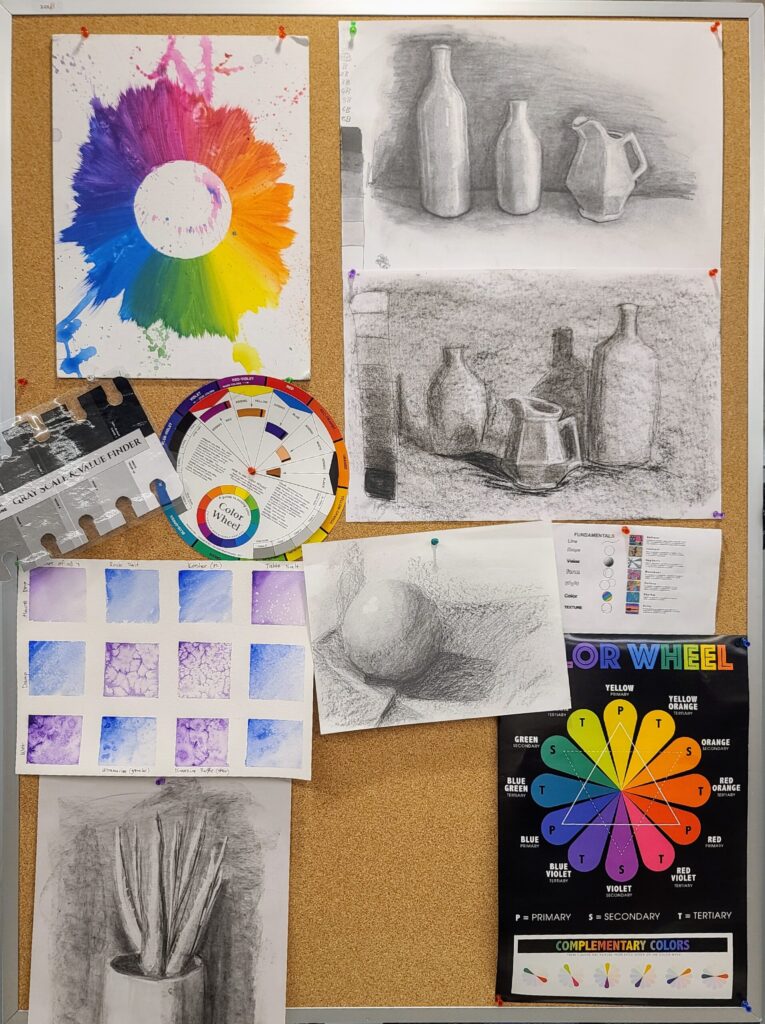When you’re just starting out as an artist, it’s tempting to dive headfirst into trendy tutorials or step-by-step painting guides. Maybe you find yourself following along with “how to paint a landscape in 15 minutes” or trying to copy a detailed eye on TikTok. While these can be fun, they rarely teach you the foundational skills you actually need to grow.
To truly develop as a painter or illustrator—whether your goal is realism, abstraction, or anything in between—you need to build your work on solid fundamentals. These are the invisible skills that make everything else possible, and skipping them can stall your growth down the road.
Here are the 7 essential art fundamentals every beginner should prioritize before chasing technique.

1. Value and Light: The Root of All Realism
Learning to see and render light is arguably the most important skill for any artist. Value refers to how light or dark something is, and it’s what gives your work the illusion of form, space, and depth.
Start with simple exercises using a single light source and basic objects like spheres, cones, or vases.
Begin by blocking in just two values: one for what’s in the light, and one for what’s in shadow. From there:
Darken your core shadows and occlusion areas (where light can’t reach).
Gently lift areas touched by bounce light.
Adjust your average light slightly darker to create contrast.
Finally, lift out the highlight—this should be the brightest point and saved for last.
Note that form shadows and cast shadows often blend together subtly. Learning to see and simplify these relationships will deepen your understanding of how light behaves.
These classic value studies may seem simple, but they build the observational muscles that support every artistic decision you make—from sketch to final painting.
2. Focus on Edges Over Lines
Unless you’re working in a style that depends heavily on line—such as animation or ink illustration—edges are far more important than outlines.
Edges describe how forms transition into one another. Some will be sharp, others soft. Learning when to lose an edge and when to sharpen one is key to realism, depth, and atmosphere.
Ditch the “outline everything” mindset. Train your eye to see edges instead.
3. Proportion and Form: Breaking It Down
Don’t try to draw a hand “perfectly” from the start. Learn to break it down into simple shapes: a trapezoid for the palm, cylinders for fingers, and a triangle where the thumb inserts.
Focus on capturing the overall form and gesture first. Once that structure is in place, then move into more specific details.
Understanding form through geometry allows you to build confidently—and when you carve out the negative space, your accuracy improves dramatically.
This method prevents you from spending hours on intricate details only to discover that the overall proportions are off or the composition is unbalanced. Think big picture first, then refine.
4. Composition and Rhythm
Composition is the arrangement of visual elements in a work of art—and it’s what guides the viewer’s eye.
Start by learning:
-Visual balance
-Focal point placement
-Apertures and framing
-Unity and rhythm across the page
Even if you’re working from reference photos, understanding how to adjust or crop for stronger composition will elevate your final result.
A great resource is Ian Roberts’ Mastering Composition (if you can find a copy), or his instructional YouTube videos that cover everything from classical composition to modern simplification.
5. Understand Color Theory and Mixing
Color theory can be overwhelming, but here’s what you need to know to get started:
Choose the right color wheel: RYB (Red-Yellow-Blue), CMY (Cyan-Magenta-Yellow), or RGB (Red-Green-Blue), depending on your medium and goals.
Learn what color harmonies are—like complementary, analogous, or triadic—and how they work within your chosen wheel.
Understand the difference between hue, tint, tone, and shade.
Practice mixing colors, not just buying every tube available.
Tips for Mixing Paint:
Some pigments are stronger than others. When mixing a dark and a light color, always start with the lighter color and slowly add the darker one. Otherwise, you’ll end up with a huge batch of unusable paint.
Learn the difference between warm and cool tones—this can affect how colors behave when mixed and how they interact on your canvas.
Always consider harmony: Does the color serve the composition, or is it distracting?
Mastering color mixing gives you more control and saves money—especially when working with limited palettes.
6. Get to Know Your Materials
You don’t need the fanciest supplies—but you do need to understand how the materials you use actually behave.
Experiment with:
-Different brushes and brush shapes
-Paper surfaces and textures
-Paint types (acrylic, watercolor, gouache)
-Drawing media (charcoal, graphite, pastel)
Each material has its own voice. The better you understand them, the more they’ll work with you, not against you.
7. Learn to Take (or Use) Good Reference Photos
Good art starts with good reference. Learning to take or choose strong reference photos makes a huge difference in your results.
When evaluating or capturing a reference, pay attention to:
Lighting direction and quality: Is the light harsh, soft, diffuse, or dramatic?
Clarity of forms: Can you clearly read the shape and structure?
Depth and atmosphere: Is there a sense of space or flatness?
Angle: Are you shooting from eye level, above, or below? How does that affect the form?
Balance and composition: Even a reference photo should have a strong visual structure.
You don’t need a fancy camera—just awareness. Learn to recognize what makes a good reference image, and you’ll dramatically improve your outcomes.
Final Thoughts: Build the House Before You Decorate It
Mastering the fundamentals isn’t glamorous, but it’s essential. Learning how to work with value, form, proportion, and composition gives you the visual literacy to grow in any direction—realism, abstraction, mixed media, digital, or traditional.
Think of it this way: Techniques are the decorations. Fundamentals are the foundation. Build the house first.
Leave a Reply